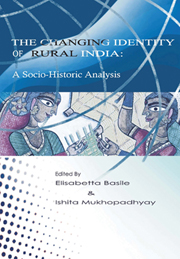Book contents
- Frontmatter
- Contents
- Acronyms and Abbreviations
- About the Authors
- INTRODUCTION
- PART 1 INDIAN RURAL TRANSFORMATIONS
- PART 2 INEQUALITY IN RURAL INDIA
- PART 3 SOCIAL MOVEMENTS AND IDENTITIES
- The Social Context of Politics in Rural West Bengal (1947–92)
- Agrarian Expansion under Colonial Rule and its Impact on a Tribal Economy
- Acting on Institutions to Preserve Agricultural Biodiversity: The Syngenta Controversy in Chhattisgarh
- The Conflicting Opinions of the Colonial Bureaucracy over the Paraiyans Right over ‘Waste’ in late 19th Century Tamil Nadu
- Appendix 1 Socio-Economic Indicators of Rural India
Acting on Institutions to Preserve Agricultural Biodiversity: The Syngenta Controversy in Chhattisgarh
from PART 3 - SOCIAL MOVEMENTS AND IDENTITIES
Published online by Cambridge University Press: 05 March 2012
- Frontmatter
- Contents
- Acronyms and Abbreviations
- About the Authors
- INTRODUCTION
- PART 1 INDIAN RURAL TRANSFORMATIONS
- PART 2 INEQUALITY IN RURAL INDIA
- PART 3 SOCIAL MOVEMENTS AND IDENTITIES
- The Social Context of Politics in Rural West Bengal (1947–92)
- Agrarian Expansion under Colonial Rule and its Impact on a Tribal Economy
- Acting on Institutions to Preserve Agricultural Biodiversity: The Syngenta Controversy in Chhattisgarh
- The Conflicting Opinions of the Colonial Bureaucracy over the Paraiyans Right over ‘Waste’ in late 19th Century Tamil Nadu
- Appendix 1 Socio-Economic Indicators of Rural India
Summary
The crucial role of institutions in agricultural development has been widely discussed, be it with regard to credit or land reforms or to incentives like support prices and subsidies. The institutionalist perspective has also been extensively used for understanding the role of institutions in natural resource management. Within both areas of study, namely agriculture and environment-related issues, scholars have tended to include the international dimension when analysing the process of designing, adapting and enforcing institutions which operate nationally and regionally. In particular, some of them have observed the emergence of a so-called global phytogenetic governance, a concept ‘commonly used in the discussion of global environmental issues to denote the more or less binding application and enforcement of norms, rules, and procedures in a given issue area’ (Thomas, 2002: p. 177). The field of agricultural biodiversity is particularly interesting, because it is regulated by two broad global regimes, one pertaining to agriculture and trade and another related to environmental conservation issues. This so-called global governance, which, in turn, impacts on local realities through the action of institutions which are designed and/or implemented at the national level, attempts at balancing competing interests. Constrasting pressures are exerted on these regimes to evolve. Bringing social movements into the picture is a way of making sense of the resistance met by institutions at the local level and also of their potential role as a pressure group impinging on institutional evolution.
- Type
- Chapter
- Information
- The Changing Identity of Rural IndiaA Sociohistoric Analysis, pp. 259 - 286Publisher: Anthem PressPrint publication year: 2009
- 1
- Cited by

